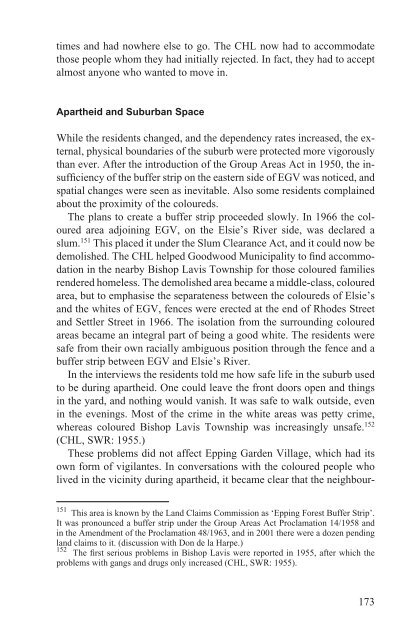The Making of a Good White - E-thesis - Helsinki.fi
The Making of a Good White - E-thesis - Helsinki.fi
The Making of a Good White - E-thesis - Helsinki.fi
Create successful ePaper yourself
Turn your PDF publications into a flip-book with our unique Google optimized e-Paper software.
times and had nowhere else to go. <strong>The</strong> CHL now had to accommodate<br />
those people whom they had initially rejected. In fact, they had to accept<br />
almost anyone who wanted to move in.<br />
Apartheid and Suburban Space<br />
While the residents changed, and the dependency rates increased, the external,<br />
physical boundaries <strong>of</strong> the suburb were protected more vigorously<br />
than ever. After the introduction <strong>of</strong> the Group Areas Act in 1950, the insuf<strong>fi</strong>ciency<br />
<strong>of</strong> the buffer strip on the eastern side <strong>of</strong> EGV was noticed, and<br />
spatial changes were seen as inevitable. Also some residents complained<br />
about the proximity <strong>of</strong> the coloureds.<br />
<strong>The</strong> plans to create a buffer strip proceeded slowly. In 1966 the coloured<br />
area adjoining EGV, on the Elsie’s River side, was declared a<br />
slum. 151 This placed it under the Slum Clearance Act, and it could now be<br />
demolished. <strong>The</strong> CHL helped <strong>Good</strong>wood Municipality to <strong>fi</strong>nd accommodation<br />
in the nearby Bishop Lavis Township for those coloured families<br />
rendered homeless. <strong>The</strong> demolished area became a middle-class, coloured<br />
area, but to emphasise the separateness between the coloureds <strong>of</strong> Elsie’s<br />
and the whites <strong>of</strong> EGV, fences were erected at the end <strong>of</strong> Rhodes Street<br />
and Settler Street in 1966. <strong>The</strong> isolation from the surrounding coloured<br />
areas became an integral part <strong>of</strong> being a good white. <strong>The</strong> residents were<br />
safe from their own racially ambiguous position through the fence and a<br />
buffer strip between EGV and Elsie’s River.<br />
In the interviews the residents told me how safe life in the suburb used<br />
to be during apartheid. One could leave the front doors open and things<br />
in the yard, and nothing would vanish. It was safe to walk outside, even<br />
in the evenings. Most <strong>of</strong> the crime in the white areas was petty crime,<br />
whereas coloured Bishop Lavis Township was increasingly unsafe. 152<br />
(CHL, SWR: 1955.)<br />
<strong>The</strong>se problems did not affect Epping Garden Village, which had its<br />
own form <strong>of</strong> vigilantes. In conversations with the coloured people who<br />
lived in the vicinity during apartheid, it became clear that the neighbour-<br />
151 This area is known by the Land Claims Commission as ‘Epping Forest Buffer Strip’.<br />
It was pronounced a buffer strip under the Group Areas Act Proclamation 14/1958 and<br />
in the Amendment <strong>of</strong> the Proclamation 48/1963, and in 2001 there were a dozen pending<br />
land claims to it. (discussion with Don de la Harpe.)<br />
152 <strong>The</strong> <strong>fi</strong>rst serious problems in Bishop Lavis were reported in 1955, after which the<br />
problems with gangs and drugs only increased (CHL, SWR: 1955).<br />
173
















